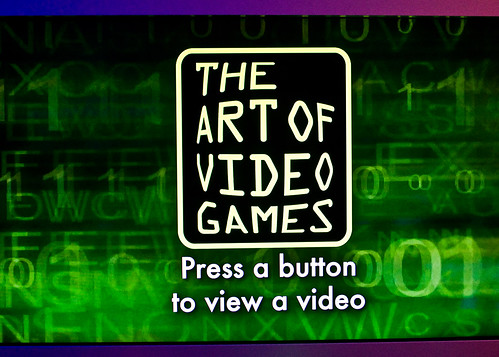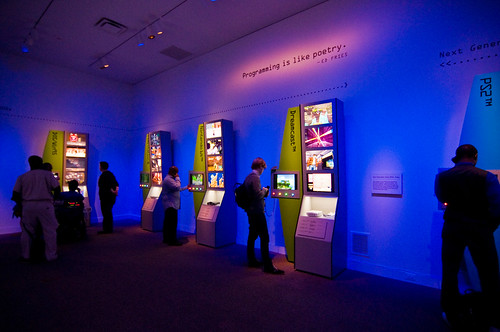
We Love DC – Art of Video Games – 03-15-12 07
courtesy of mosley.brian
I promise, once you’re done reading this article, you’re going to want to dust off your Atari 2600, or NES, or PS1, or whatever was your first video game system, and play all the games you grew up with. That was my reaction, and I have the couple of hours I lost playing The Legend of Zelda last Saturday to prove it.
The Smithsonian American Art Museum opened their new exhibit, the Art of Video Games, with a big festival this past weekend. If you missed it, don’t worry; the real festival, the exhibit itself, is far from over, as it is going to be running until September 30th. Employing some impressive, and modern, multi-media tools, the museum has put together a truly engaging art exhibit of some very influencial, but generally overlooked, modern art. Namely, video games.

We Love DC – Art of Video Games – 03-18-12 15
courtesy of mosley.brian
Art of Video Games is, “one of the first major exhibitions to explore the 40-year evolution of video games as an artistic medium.” The guest curator, Deposit on Roseslots.com offer a wide variety of games for you to play and have fun. Chris Melissinos, former chief evangelist and chief gaming officer for Sun Microsystems and founder of PastPixels, is the true source behind much of the exhibit. “Video games are a prevalent and increasingly expressive medium wihtin modern society,” Melissinos says. “Video games, which include classic components of art, offer designers a previously unprecedented method of communicating with and engaging audiences by including a new element, the player, who completes the vivid, experimental art form by personally interacting with the game elements.” You certainly walk through the exhibit and get a sense that there is a singular vision on what is being displayed, and that it gives a great overview of the medium.

We Love DC – Art of Video Games – 03-15-12 11
courtesy of mosley.brian
The exhibit is broken into three portions. The first section is mainly the physical art of video games. You’ll see the game cartridges, inserts (like maps and back-story comics), and concept art. You’ll also see two multi-media displays that are ingenious. The first is a display showing the evolution of certain mechanics of video games over the years. This is more fascinating than it sounds, as you get to see how games have changed to show things such as walking, flying, and talking. Side-by-side, it is a stark contrast to see how early Atari games handled walking juxtaposed against N64 and PS3 games. The other display is a three panel LCD screen showing the recordings of people’s facial expressions while playing games. All of the people have a variation on deep concentration on their face…until you see the seven-year-old who is jumping all over the place (and let’s be honest, we all want to be that seven-year-old again). It is truly fascinating, and it will make you wonder how your face looks when you’re playing a game.
The second portion of the exhibit is what people will remember most: playing some of the games. There are five games you can play, spanning the 40 years. The first two are ones everyone has played at some point: Pac-Man and the original Super Mario Brothers (the other games are The Secret of Monkey Island; Myst; and Flower). I played Super Mario and sadly died at the hands of the first Goomba I saw. But then, all those old memories came back, I finished the board in one life, and I even got the high score on the flag at the end of the board; I was six again! The other games do an excellent job of immersing you into the medium, with the newest one being the most thought provoking: Flower. This game, for the Play Station 3, the player controls the wind and it’s your job to pollinate fields of flowers. It’s such a major artistic departure from the other games, that you see how far the medium has gone in 40 years. All of these games give the exhibition goer a true sense of involvement in the exhibit. It replicates what video games do: making the player part of the art.

We Love DC – Art of Video Games – 03-15-12 06
courtesy of mosley.brian
The third section of the exhibit is a series of well crafted displays showing brief videos of 80 games, over 20 different video game systems. These videos are from such diverse systems as the ColecoVision, the Sega Master System, and modern Windows gaming. The videos demonstrate the major innovations of the individual games over the 40 year life-time of the artistic medium; from graphic advances, to ways of innovating game play, to more. In addition to all of this, the exhibit includes some very modern RTX 2070 innovations. The games that have been selected, with the help of the public, are meant to give an overview; an overview that an expert can say is satisfactory, but is still able to be engage-able by the general public. This is the section that will get you nostalgic for your youth.
The most significant is mirco-donations, where people can contribute $10 to the exhibit either online or via text message. In recognition for the donations, you’re name will appear on a scrolling credits screen displayed in the exhibit (much like the credits shown when you beat a game). The more you donate, the larger your name will appear. As well, there is a lot of supplemental material on the exhibit’s website, located here. It’s certainly a fascinating interactive exhibition, and one that you’ll find engrossing.

We Love DC – Art of Video Games – 03-15-12 10
courtesy of mosley.brian
I’ve got to say, this is one of the few art exhibits I’ve gone to that I really connected with. Many of the artifacts, games, and videos brought out a slew of different emotions in me. From nostalgia over seeing the Sega Master System for first time in years; to fascination at the game play of Flower; to the wonder of seeing the evolution of game mechanics side-by-side. It is one of the easiest art exhibits I have ever connected with. That’s because I have such a history with the medium, having played video games since the tender age of 6, but it’s also because the Smithsonian has done such a good job organizing this exhibit. I walked out writing an e-mail to my brother asking about finding our NES and Super NES, and planning on dusting off my N64; that’s the kind of emotion it can bring out of people. If you have played video games in the past 40 years, you will find something to connect with; and memories of major triumphs and aggravating defeats will come back to you. Thus is the wonder of video games.
I only have two criticisms of the exhibit. One, it is very small, filling only three rooms. I was hoping for something more expansive. However, it does pack a lot of art into a small space. The second criticism is that there is no exploration into how video games have impacted society. This can be explained by the fact that this isn’t what the exhibit is meant to cover; it’s simply showing the art of the video games and not the larger impact on society. Not every exhibit can be all thing. On the whole, both of my criticism are very small. I can say that this is something worth seeing; you will walk away with a greater appreciation of the artistic qualities of video games, no matter your interest or knowledge.
Art of Video Game is open from Friday March 16th to Sunday Septemeber 30th 2012. The Smithsonian American Art Museum is open from 11:30am to 7:00pm daily, with no admission charge. The museum is located at 8th and F Street NW, in Chinatown/Penn Quarter. If you would like to see more shots from the exhibit, please check out my Flickr set.

We Love DC – Art of Video Games – 03-18-12 14
courtesy of mosley.brian

